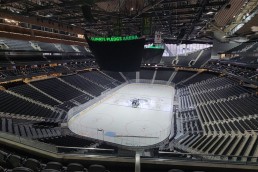This website uses cookies so that we can provide you with the best user experience possible. Cookie information is stored in your browser and performs functions such as recognising you when you return to our website and helping our team to understand which sections of the website you find most interesting and useful.
Climate Pledge Arena
ProjectClimate Pledge ArenaLocationSeattle, United StatesManufacturersPowersoftInstallerIdibri USSubmitted byPowersoft
Since its grand re-opening in October 2021, Seattle’s Climate Pledge Arena has set its sights on becoming the most progressive, responsible, and sustainable arena in the world, naming Carbon Zero status, Zero Single-Use Plastic Use, Water Conservation, and Zero Waste as some of its initial ambitions.
The ambition for the venue is to be the first net zero certified arena in the world. Practically, this means the arena has committed to the following in particular:
– No fossil fuel consumption in the arena for daily use: mechanical systems, gas combustion engines, heating, dehumidification, and cooking – all converted to electric.
– Usage of solar panels on the Alaska Airlines Atrium and 1st Ave Garage combined with off-site supplementary renewable energy for 100% renewable energy power.
– Reduction of all carbon emission activities and offset all those that can’t be – like transportation – by purchasing credible carbon offsets
– Eliminate single-use plastics, with a 100% free commitment by 2024. Water bottle filling stations available throughout the arena
– Harvesting water off the roof thanks to a “Rain to Rink” system, turning it into the greenest ice in the NHL
– Waterless urinals and ultra-efficient showers
– Significant on-site retention tanks to reduce stormwater runoff
– Onsite waste sorting, composting and recycling
The world class arena, reinvigorated thanks to $1.15 billion (USD) of private investment, has been designed to host a number of events, including hockey matches, basketball games, and live concerts, providing a premium experience to a capacity crowd of up to 18,100 guests.
David Battershell – senior consultant at Idibri, a Salas O’Brien Company – was the AV design consultant for the arena’s extensive renovation, with Idibri acting as the AV component of a larger Populous design machine.
“Basically, the project was a ‘renovation’ of an existing arena that was too small and outdated,” Battershell explained. “The arena’s roof is a historic landmark and couldn’t be torn down, so it had to be lifted off for work to begin. The rest of the building was then completely dismantled, the floor was lowered 20ft, and the new arena was built up to where the original roof would eventually be replaced.”
Idibri was brought in to provide high quality audio in the arena’s suites to support bowl audio extension, background music, and local TV audio.
Battershell and his team decided that Powersoft’s Mezzo compact amplifier platforms would be an ideal fit for such a demanding application.
“We thought that the Mezzo would be well-suited to being installed behind the televisions in each of the suites,” he said. “We used them to provide an audio input for local TV audio, amplification for local speakers, and IP audio connection to the bowl audio feeds. Mezzo has the exact feature set that we wanted, as well as being very well-priced for such high quality.”
The bowl audio feeds were designed to come from a single FOH console via Dante and stream to the Mezzo infrastructure, comprised of 58 units. Local audio from TVs themselves were connected directly via the analogue inputs on the Mezzo units, while Bluetooth audio inputs (AtteroTech unD6IO-BT) were able to steam to Mezzo via Dante. The Mezzo units were controlled by Crestron.
“We thought that the Mezzo would be well-suited to being installed behind the televisions in each of the suites,” he said. “We used them to provide an audio input for local TV audio, amplification for local speakers, and IP audio connection to the bowl audio feeds. Mezzo has the exact feature set that we wanted, as well as being very well-priced for such high quality.”
The bowl audio feeds were designed to come from a single FOH console via Dante and stream to the Mezzo infrastructure, comprised of 58 units. Local audio from TVs themselves were connected directly via the analogue inputs on the Mezzo units, while Bluetooth audio inputs (AtteroTech unD6IO-BT) were able to steam to Mezzo via Dante. The Mezzo units were controlled by Crestron.



